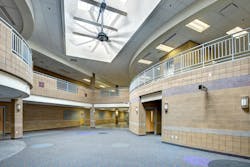Enhancing air quality
Five years have passed since the outbreak of Covid-19 infected millions and led to the cancellation of nearly all classroom instruction across the nation. Schools and universities learned many lessons as they navigated the path from total shutdown to remote online instruction to an eventual reopening of campuses.
A key takeaway for administrators and educators who managed facilities during the Covid-19 pandemic was a heightened awareness of how potentially hazardous viruses can spread through the air inside a building and a greater understanding of the critical role that providing well-ventilated classrooms has in protecting students and staff from disease.
For many education institutions, the pursuit of better ventilation and healthful indoor air quality led them to allocate some of their federal Covid relief funds for upgrading or replacing HVAC systems. Some schools and universities also have installed air cleaners with high-efficiency particulate air (HEPA) filters to further enhance the indoor air quality in classrooms and other learning spaces.
Those improvements appear to be wise decisions, according to the results from a couple of recent studies that examined how HVAC upgrades and the use of HEPA filters affected indoor air quality in school facilities.
“We find that improvements in school HVAC system conditions over time reduce student absence, reduce student suspension, and modestly increase student math and reading scores,” a study from the Annenberg Institute at Brown University concluded “Heating and cooling system replacements and reconstructions also increase student math achievement. We conclude that investments made now to improve school HVAC systems can benefit not only student comfort and well-being, but also enhance educational opportunity.”
In another study, researchers at the University of California Irvine’s Joe C. Wen School of Population & Public Health found that adding portable high-efficiency particulate air (HEPA) air cleaners to classrooms that already had existing HVAC systems with air filters resulted in lower measurable particulate matter concentrations and less infiltration of outdoor particulate matter compared with control classrooms with non-HEPA filters.
“This demonstrates that further improvements in classroom air quality, especially in environmentally burdened communities, can be achieved with additional filtration,” the Irvine study says.
Upgrading HVAC
The Annenberg Institute study, “The Effects of School Building HVAC System Conditions on Student Academic and Behavioral Outcomes,” was conducted by Lucy C. Sorensen, Moonae Hwang and Marzuka Ahmad Radia, researchers at SUNY Albany. They examined data from 2,600 public school buildings in New York state (excluding New York City) from 2005-06 to 2018-19.
“Overall, the study found that poor HVAC system conditions negatively impact student outcomes, while improvements and replacements in these systems lead to measurable gains in attendance, behavior, and academic performance,” the study says.
The researchers found that cooling system replacements boosted math scores by 3%, and heating system replacements led to a rise of 4%. Improved heating system conditions led to a 3% decline in absenteeism, a 6% drop in suspension rates, and a 5% rise in math scores. Better ventilation systems led to a 2% reduction in absenteeism and a 7% drop in suspension rates.
The study also found that schools serving larger proportions of economically disadvantaged students, as well as those with more Black and Hispanic students, were more likely to have unsatisfactory or non-functional HVAC systems.
The authors provided several possible explanations for the improvements found in upgraded HVAC systems:
- Better ventilation improves air quality, which could reduce illnesses like asthma that contribute to absenteeism.
- Improved heating and cooling systems create more comfortable learning environments, enhancing focus and reducing classroom disruptions.
- Effective ventilation systems help prevent the transmission of airborne diseases, which could lead to fewer absences.
“While the effects of better HVAC systems are modest, they are consistent enough to support the argument that investments in school infrastructure—particularly HVAC systems—would boost educational outcomes and address longstanding inequities,” the study says “The findings also align with a growing body of research that shows school building conditions, including air quality, temperature regulation, and overall maintenance, have positive effects on student success.”
HEPA helps
The UC Irvine study by authors Shayna C. Simona, Scott M. Bartell and Veronica M. Viera sought to assess whether adding HEPA filter air cleaners to classrooms with existing HVAC system reduces exposure to indoor air pollution. The researchers monitored particulate matter (PM) concentrations during 2022-23 and 2023-24 in classrooms at 17 schools in the Los Angeles Unified District. Each classroom had an existing HVAC system maintained by the school district that used minimum efficiency reporting value (MERV) 13 filters since the Covid-19 pandemic.
The schools were chosen because they were near the Port of Los Angeles, major highways, industries, and oil refineries, areas where air quality has historically been poor compared with other areas of the district.
“Not all classrooms have the same air quality—especially in communities with lower socioeconomic status and higher minority populations, where children are often exposed to more air pollution,” said Vieira, chair and professor of environmental and occupational health.
The study found that adding portable HEPA air cleaners to classrooms that already had HVAC systems with MERV 13 air filters resulted in lower measurable PM concentrations and less infiltration of outdoor PM compared with control classrooms with non-HEPA filters. In HEPA classrooms, the average PM concentration was 39.9% lower and infiltration of outdoor PM into classrooms was 13.8% to 82.4% lower than non-HEPA classrooms.
“When properly maintained, portable air cleaners with HEPA filters are effective at removing PM from classrooms,” the study concluded. “Our findings provide support for the use of portable air cleaners with HEPA filters in classrooms to reduce PM, even in classrooms with existing HVAC air filtration.”
Mike Kennedy, AS&U senior editor, can be reached at [email protected]
